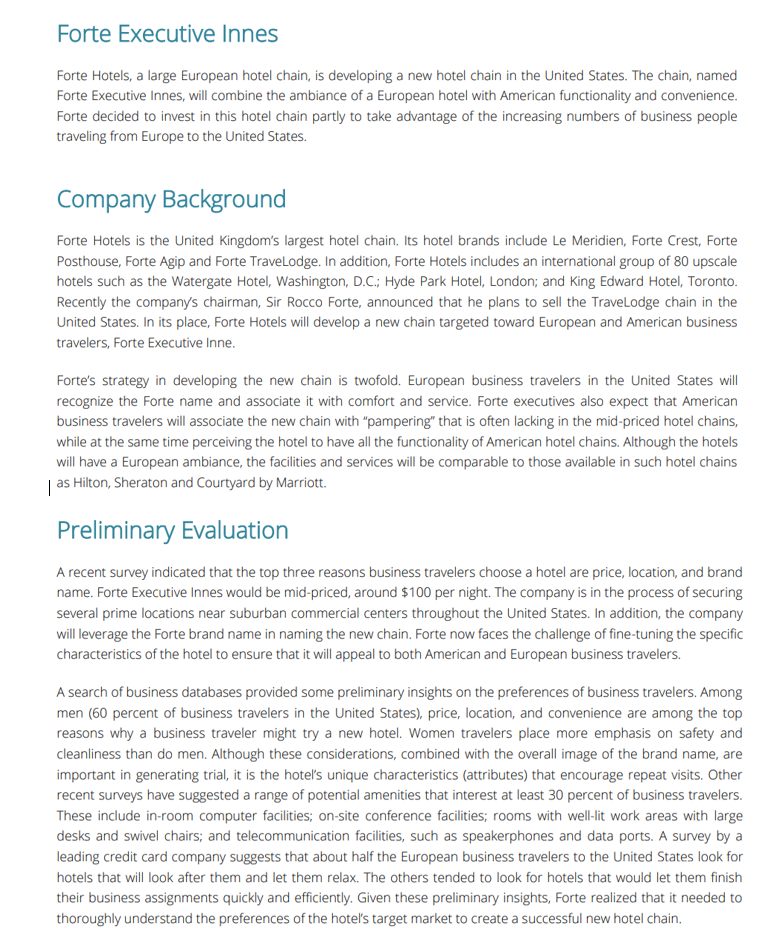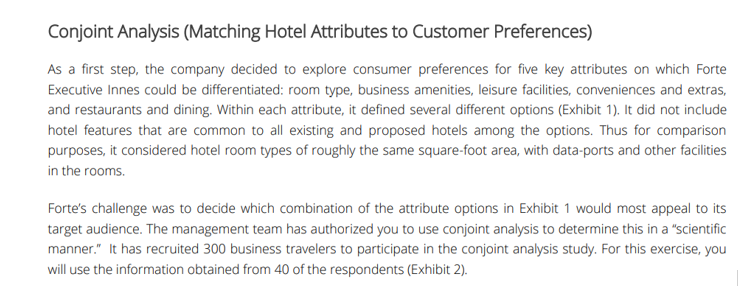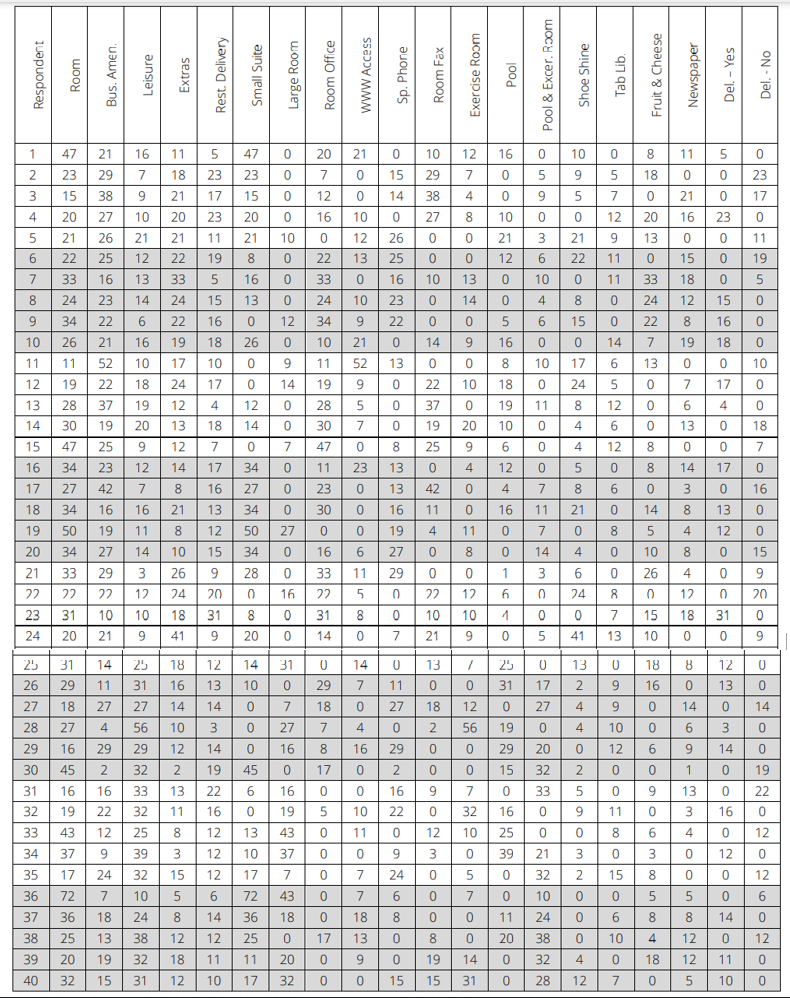




- Design: Using the Enginius Templates, select Conjoint. Follow Step 1 in the Conjoint Tutorial and develop a Study Design Template for Forte, using the attributes and levels from Exhibit 1. Next, follow Step 2 in the Tutorial, Create a data collection instrument, selecting "Ratings" method and populate a row with your ratings (e.g., on a scale of 0-100 rate each combination of attributes). When you are done, check to be sure that your sheet looks like the "Forte Hotel Conjoint ratings" data found in Enginius. Then, briefly summarize the advantages and limitations of describing products as bundles of attribute options.
- Utility assessment: Using the sheet that you created in Question 1, rate each of the bundles, giving your most preferred bundle "100" and your least preferred bundle "0," as described in Step 3 in the Tutorial. When you are done, follow Step 4 in the Tutorial and perform a utility assessment for yourself (Using Enginius, do Conjoint Analysis, using your ratings but without running any Simulations). Interpret your own preferences on the resulting Part Worths Sheet.
Based on your experiences in completing these tasks, summarize the advantages and limitations of conjoint analysis for obtaining preference data from customers
- Analysis: Open the Forte Hotel Case Study and assess the viability of the four specific hotel concepts that Forte is exploring for the State College area. Base this evaluation on the preferences of a sample of 40 business travelers on that sheet (Exhibit 2) and the cost estimates summarized in Exhibit 3. The base cost to build each hotel room (without the attributes and options listed in Exhibit 3) is expected to be about $40,000 for a 150- to 200-room hotel, regardless of the mix of room types. Identify the optimal product concept from among those Forte is considering. Explain how you arrived at your recommendation.
- Would you recommend product concepts other than the four Forte is considering for the State College market? Explain how you arrived at your recommendation(s).
- Summarize the major advantages and limitations of a conjoint study for new product design. What conditions favor the use of this approach in the hotel industry? (Consider such factors as types of customers and market conditions in responding to this question.)
- After hearing about the study, a manager at Forte claimed that A conjoint study is a major deterrent to excellence in hotel design. Its a crutch for managers with no vision and conviction. On the surface, it sounds sensible enough: find out exactly what features customers prefer before you finalize the design. But in practice, this is impossible. Customers cannot tell you what they really prefer without experiencing all the choices available to them. Even if you show them pictures or prototypes, the preferences they express are apt to veer off in the direction of mediocrity. This type of study gives you a Hyundai with a Mercedes grille, Prince tennis rackets endorsed by Ed McMahon, Big Macs with everything, and hotels with no personality! You would not produce a Mazda Miata, a Hermes tie or the movie Jurassic Park with this technique. Do you agree with this statement? Why or why not?
Forte Executive Innes Forte Hotels, a large European hotel chain, is developing a new hotel chain in the United States. The chain, named Forte Executive Innes, will combine the ambiance of a European hotel with American functionality and convenience. Forte decided to invest in this hotel chain partly to take advantage of the increasing numbers of business people traveling from Europe to the United States. Company Background Forte Hotels is the United Kingdom's largest hotel chain. Its hotel brands include Le Meridien, Forte Crest, Forte Posthouse, Forte Agip and Forte Travelodge. In addition, Forte Hotels includes an international group of 80 upscale hotels such as the Watergate Hotel, Washington, D.C.; Hyde Park Hotel, London; and King Edward Hotel, Toronto. Recently the company's chairman, Sir Rocco Forte, announced that he plans to sell the Travelodge chain in the United States. In its place, Forte Hotels will develop a new chain targeted toward European and American business travelers, Forte Executive Inne. Forte's strategy in developing the new chain is twofold. European business travelers in the United States will recognize the Forte name and associate it with comfort and service. Forte executives also expect that American business travelers will associate the new chain with pampering" that is often lacking in the mid-priced hotel chains, while at the same time perceiving the hotel to have all the functionality of American hotel chains. Although the hotels will have a European ambiance, the facilities and services will be comparable to those available in such hotel chains | as Hilton, Sheraton and Courtyard by Marriott. Preliminary Evaluation A recent survey indicated that the top three reasons business travelers choose a hotel are price, location, and brand name. Forte Executive Innes would be mid-priced, around $100 per night. The company is in the process of securing several prime locations near suburban commercial centers throughout the United States. In addition, the company will leverage the Forte brand name in naming the new chain. Forte now faces the challenge of fine-tuning the specific characteristics of the hotel to ensure that it will appeal to both American and European business travelers. A search of business databases provided some preliminary insights on the preferences of business travelers. Among men (60 percent of business travelers in the United States), price, location, and convenience are among the top reasons why a business traveler might try a new hotel. Women travelers place more emphasis on safety and cleanliness than do men. Although these considerations, combined with the overall image of the brand name, are important in generating trial, it is the hotel's unique characteristics (attributes) that encourage repeat visits. Other recent surveys have suggested a range of potential amenities that interest at least 30 percent of business travelers. These include in-room computer facilities; on-site conference facilities; rooms with well-lit work areas with large desks and swivel chairs; and telecommunication facilities, such as speakerphones and data ports. A survey by a leading credit card company suggests that about half the European business travelers to the United States look for hotels that will look after them and let them relax. The others tended to look for hotels that would let them finish their business assignments quickly and efficiently. Given these preliminary insights, Forte realized that it needed to thoroughly understand the preferences of the hotel's target market to create a successful new hotel chain. Conjoint Analysis (Matching Hotel Attributes to Customer Preferences) As a first step, the company decided to explore consumer preferences for five key attributes on which Forte Executive Innes could be differentiated: room type, business amenities, leisure facilities, conveniences and extras, and restaurants and dining. Within each attribute, it defined several different options (Exhibit 1). It did not include hotel features that are common to all existing and proposed hotels among the options. Thus for comparison purposes, it considered hotel room types of roughly the same square-foot area, with data-ports and other facilities in the rooms. Forte's challenge was to decide which combination of the attribute options in Exhibit 1 would most appeal to its target audience. The management team has authorized you to use conjoint analysis to determine this in a "scientific manner." It has recruited 300 business travelers to participate in the conjoint analysis study. For this exercise, you will use the information obtained from 40 of the respondents (Exhibit 2). Exhibits Attribute [Abbreviation] Possible Options (Abbreviation] Room Type (All same size) [Room] Small suite (sm_suite] A small suite with a small bedroom area and a separate sitting area with a couch, TV, and coffee table. Large standard room [lg_room] A room about three feet longer than a standard room with two queen-sized beds. Room with large desk and swivel chair (rm_office) A room of the same dimensions as the large standard room with only one queen-sized bed and a well-lit work area with a large desk and swivel chair in place of the other bed. World Wide Web (WWW) access [www_access] A computer complete with software (e.g. Netscape) with access to the Internet and the WWW, at a low hourly connection rate ($2 to $3 per hour). Speakerphone in room (sp_phone] A speakerphone for group business discussions. In-room fax machine (room_fax] A fax machine and a private fax number that expires at checkout. Business Amenities [Bus_amen] Leisure Facilities [Leisure] Exercise room (exerc_room) A room, open 24 hours a day, equipped with Nautilus machines, free weights, stationary bikes, treadmills, stairclimbing machines, and a sauna. Pool (pool) A standard rectangular indoor lap pool with shallow and deep ends. Small exercise room and small pool [exerc+pool] A round pool for recreational swimming not a lap pool, and an exercise room that lacks some features described above (e.g., no sauna and fewer machines). Conveniences & Extras [Extras) Complimentary shoe shine (shoe_shine) Shoes left at the front desk or outside the room at night are shined and returned by a specified time in the morning. Videotape library [tape_lib) A large selection of tapes will be listed in a catalog in the room and available through room service. Complimentary fruit and cheese bowl [ft+cheese] A complimentary fruit and gourmet cheese bowl in the room. Free newspaper [newspaper] A complimentary copy of USA Today outside the door. Restaurant Delivery Yes [yes] From a book of menus from nearby restaurants, patrons can order food through room service, and a hotel employee will pick up and deliver the food. No [no] No restaurant delivery service available. [Restrn_del) Respondent NI Room Bus. Amen. Leisure Extras SERRRRANOWBRISURENDUM Rest. Delivery Small Suite Large Room Room Office WWW Access Sp. Phone Room Fax | Exercise Room Pool Pool & Excer. Room Shoe Shine Tab Lib. Fruit & Cheese Newspaper Del. - Yes Del. - No Incremental fixed costs per room ($) at the time of construction Average expected incremental contribution per day per room ($) WWW access 2,500 3.00 200 2.00 Speaker phone in room In-room fax machine 600 2.50 Exercise room 1,500 -2.00 Pool 3,000 -4.00 Small exercise room & small pool 3,500 -4.50 30 -0.50 300 -0.50 Complimentary shoe shine Videotape library Complimentary fruit & cheese bowl Newspaper 100 -5.00 -1.00 100 -3.00 Restaurant delivery No restaurant delivery Forte Executive Innes Forte Hotels, a large European hotel chain, is developing a new hotel chain in the United States. The chain, named Forte Executive Innes, will combine the ambiance of a European hotel with American functionality and convenience. Forte decided to invest in this hotel chain partly to take advantage of the increasing numbers of business people traveling from Europe to the United States. Company Background Forte Hotels is the United Kingdom's largest hotel chain. Its hotel brands include Le Meridien, Forte Crest, Forte Posthouse, Forte Agip and Forte Travelodge. In addition, Forte Hotels includes an international group of 80 upscale hotels such as the Watergate Hotel, Washington, D.C.; Hyde Park Hotel, London; and King Edward Hotel, Toronto. Recently the company's chairman, Sir Rocco Forte, announced that he plans to sell the Travelodge chain in the United States. In its place, Forte Hotels will develop a new chain targeted toward European and American business travelers, Forte Executive Inne. Forte's strategy in developing the new chain is twofold. European business travelers in the United States will recognize the Forte name and associate it with comfort and service. Forte executives also expect that American business travelers will associate the new chain with pampering" that is often lacking in the mid-priced hotel chains, while at the same time perceiving the hotel to have all the functionality of American hotel chains. Although the hotels will have a European ambiance, the facilities and services will be comparable to those available in such hotel chains | as Hilton, Sheraton and Courtyard by Marriott. Preliminary Evaluation A recent survey indicated that the top three reasons business travelers choose a hotel are price, location, and brand name. Forte Executive Innes would be mid-priced, around $100 per night. The company is in the process of securing several prime locations near suburban commercial centers throughout the United States. In addition, the company will leverage the Forte brand name in naming the new chain. Forte now faces the challenge of fine-tuning the specific characteristics of the hotel to ensure that it will appeal to both American and European business travelers. A search of business databases provided some preliminary insights on the preferences of business travelers. Among men (60 percent of business travelers in the United States), price, location, and convenience are among the top reasons why a business traveler might try a new hotel. Women travelers place more emphasis on safety and cleanliness than do men. Although these considerations, combined with the overall image of the brand name, are important in generating trial, it is the hotel's unique characteristics (attributes) that encourage repeat visits. Other recent surveys have suggested a range of potential amenities that interest at least 30 percent of business travelers. These include in-room computer facilities; on-site conference facilities; rooms with well-lit work areas with large desks and swivel chairs; and telecommunication facilities, such as speakerphones and data ports. A survey by a leading credit card company suggests that about half the European business travelers to the United States look for hotels that will look after them and let them relax. The others tended to look for hotels that would let them finish their business assignments quickly and efficiently. Given these preliminary insights, Forte realized that it needed to thoroughly understand the preferences of the hotel's target market to create a successful new hotel chain. Conjoint Analysis (Matching Hotel Attributes to Customer Preferences) As a first step, the company decided to explore consumer preferences for five key attributes on which Forte Executive Innes could be differentiated: room type, business amenities, leisure facilities, conveniences and extras, and restaurants and dining. Within each attribute, it defined several different options (Exhibit 1). It did not include hotel features that are common to all existing and proposed hotels among the options. Thus for comparison purposes, it considered hotel room types of roughly the same square-foot area, with data-ports and other facilities in the rooms. Forte's challenge was to decide which combination of the attribute options in Exhibit 1 would most appeal to its target audience. The management team has authorized you to use conjoint analysis to determine this in a "scientific manner." It has recruited 300 business travelers to participate in the conjoint analysis study. For this exercise, you will use the information obtained from 40 of the respondents (Exhibit 2). Exhibits Attribute [Abbreviation] Possible Options (Abbreviation] Room Type (All same size) [Room] Small suite (sm_suite] A small suite with a small bedroom area and a separate sitting area with a couch, TV, and coffee table. Large standard room [lg_room] A room about three feet longer than a standard room with two queen-sized beds. Room with large desk and swivel chair (rm_office) A room of the same dimensions as the large standard room with only one queen-sized bed and a well-lit work area with a large desk and swivel chair in place of the other bed. World Wide Web (WWW) access [www_access] A computer complete with software (e.g. Netscape) with access to the Internet and the WWW, at a low hourly connection rate ($2 to $3 per hour). Speakerphone in room (sp_phone] A speakerphone for group business discussions. In-room fax machine (room_fax] A fax machine and a private fax number that expires at checkout. Business Amenities [Bus_amen] Leisure Facilities [Leisure] Exercise room (exerc_room) A room, open 24 hours a day, equipped with Nautilus machines, free weights, stationary bikes, treadmills, stairclimbing machines, and a sauna. Pool (pool) A standard rectangular indoor lap pool with shallow and deep ends. Small exercise room and small pool [exerc+pool] A round pool for recreational swimming not a lap pool, and an exercise room that lacks some features described above (e.g., no sauna and fewer machines). Conveniences & Extras [Extras) Complimentary shoe shine (shoe_shine) Shoes left at the front desk or outside the room at night are shined and returned by a specified time in the morning. Videotape library [tape_lib) A large selection of tapes will be listed in a catalog in the room and available through room service. Complimentary fruit and cheese bowl [ft+cheese] A complimentary fruit and gourmet cheese bowl in the room. Free newspaper [newspaper] A complimentary copy of USA Today outside the door. Restaurant Delivery Yes [yes] From a book of menus from nearby restaurants, patrons can order food through room service, and a hotel employee will pick up and deliver the food. No [no] No restaurant delivery service available. [Restrn_del) Respondent NI Room Bus. Amen. Leisure Extras SERRRRANOWBRISURENDUM Rest. Delivery Small Suite Large Room Room Office WWW Access Sp. Phone Room Fax | Exercise Room Pool Pool & Excer. Room Shoe Shine Tab Lib. Fruit & Cheese Newspaper Del. - Yes Del. - No Incremental fixed costs per room ($) at the time of construction Average expected incremental contribution per day per room ($) WWW access 2,500 3.00 200 2.00 Speaker phone in room In-room fax machine 600 2.50 Exercise room 1,500 -2.00 Pool 3,000 -4.00 Small exercise room & small pool 3,500 -4.50 30 -0.50 300 -0.50 Complimentary shoe shine Videotape library Complimentary fruit & cheese bowl Newspaper 100 -5.00 -1.00 100 -3.00 Restaurant delivery No restaurant delivery











